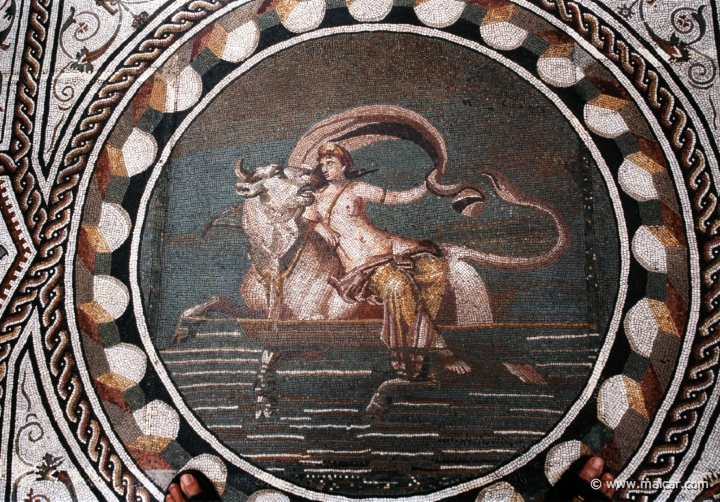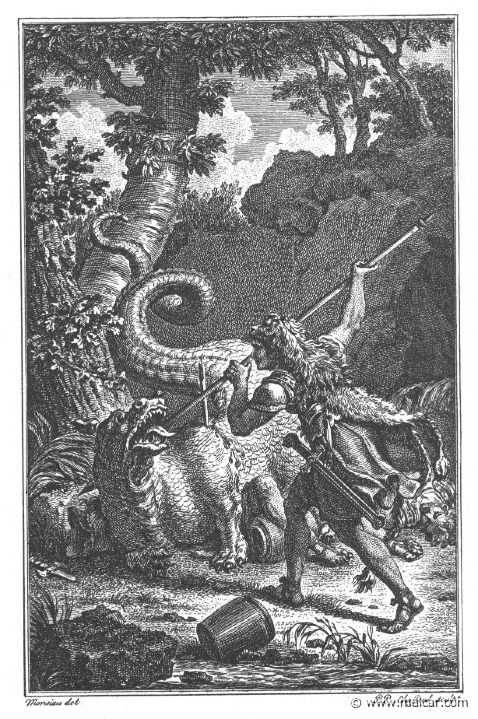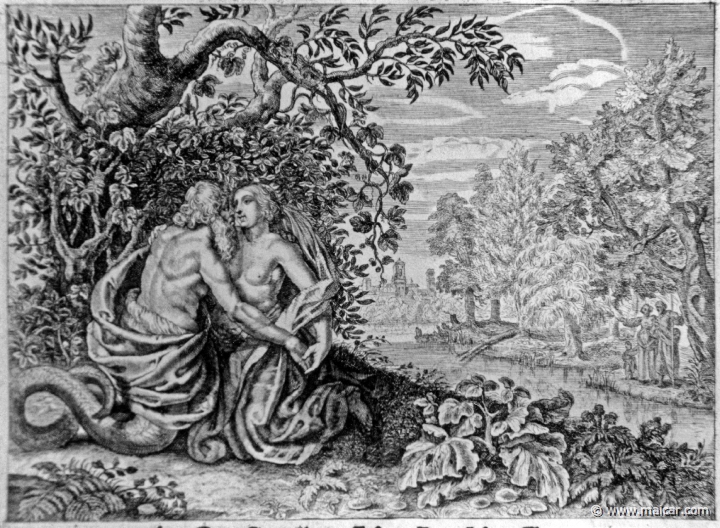|

|
5104: Europa. Roman mosaic.
|
|
|
"Cadmus, in vain you travel round and round ... You seek a bull which no cow ever calved; you seek a bull which no mortal knows how to find ... Europa's bridegroom no drover knows how to drive ... he is ordered by no whip...he strains his neck for Love alone ..." (The Pythian priestess to Cadmus. Nonnos, Dionysiaca 4.293).
|
|
Cadmus, in search of his abducted sister Europa, settled in Boeotia, which some say he invaded with a Phoenician army, founding in this new land the city of Cadmea, later called Thebes. Cadmus is credited for having combined consonants with vowels, thus teaching the secrets of correct speech. These events took place approximately 200 years before the Trojan War.
Lost princess
When the princess Europa disappeared from the coasts of Phoenicia on the back of a bull, her father Agenor 1, son of King Belus 1 of Egypt and Anchinoe, the daughter of the river god Nilus, sent his sons in search of her, telling them not to return until they had found their sister.
Europa never found
However, nothing was ever found resembling the lost princess, except for the name of the land called Europa, which is that part of the inhabited world lying north of the Peloponnesus and beyond; for she, after having being conveyed through the sea by Zeus the bull, was set down by him, quite dry, upon the shore by Mount Dicte in Crete.
Brothers disperse as they search for her
Her brother Phoenix 1 gave up the search for Europa, and settled in some part of Phoenicia, which was called after him, and so did Cilix, who became king in Cilicia, the southeasternmost coastal region of Asia Minor, and so did Thasus, who also gave up the search and settled in an large island off Thrace, in the northern section of the Aegean Sea, founding a city Thasos. Also other relatives, brothers or perhaps cousins, went away in search of Europa. Cepheus 1, son of Belus 1 or of Phoenix 1 and father of Andromeda, the wife of Perseus 1, settled in Ethiopia; and Phineus 2, whom the ARGONAUTS are said to have met though it sounds unlikely, became king of Salmydessus in Thrace.
Cadmus leaves settlers in famous island
When Cadmus, who some say was from the city of Tyros, sailing northwards from Sidon in Phoenicia, put ashore at Calliste, the island north of Crete later called Thera (Santorini), he left on this island a group of settlers under the leadership of Membliarus, son of Poeciles. Calliste came to be called Thera because many generations later Theras (son of Autesion 1, son of Tisamenus 1, son of Thersander 1, son of Polynices, son of Oedipus, son of Laius 1, son of Labdacus 1, son of Polydorus 2, son of Cadmus) came to the island to claim his rights. On Theras' arrival to Calliste, the descendants of Membliarus gave up the kingship to him of their own accord, for they considered that Theras' family went back to Cadmus himself. And so Theras, having become king, renamed the island, and called it Thera after himself.
Cadmus in Thrace and Samothrace
Having left Calliste then, Cadmus came, accompanied by his mother Telephassa, to Thrace, which is the region between the Black and Aegean seas, and settled there. Some have said that Cadmus was taught initiatory rites by Iasion when he, in search of her sister Europa, came to Samothrace, the island in the northern Aegean sea, and they suppose that it was here that Cadmus married Harmonia 1.
Cadmus in Delphi
After his mother's death, Cadmus came to Delphi to inquire about Europa, but the oracle told him no to worry about his sister and instead, letting himself be guided by a cow, found a city in the place where the animal should stop to rest. So Cadmus, obeying the oracle, journeyed through Phocis, which is the region bordering the northern coast of the Gulf of Corinth, and having met a cow, followed it behind until it fell down for weariness in that same spot in Boeotia where Cadmus founded the city of Cadmea, later called Thebes.
The Dragon of Ares
When the place for the new city, through such an amazing method, was determined, Cadmus decided to sacrifice the cow to the goddess Athena. With that purpose in mind, he sent some of his men to draw water from the spring later called Dirce (some have said Castalia), belonging to Ares, which happened to be guarded by a dragon said to be the offspring of the god, or sacred to him. This dragon, which had a golden crest, flashed fire from his eyes, had a triple tongue, teeth ranged in triple row, and the body swollen with poison, devoured Cadmus' companions. But when he discovered that the beast was the reason why those who were sent after water never returned, he confronted it and killed it, sowing, by the advice of Athena, its teeth in the earth.
|

|
01081: Cadmus killing the Dragon of Ares. "But Cadmus follows him up and presses the planted point into his throat; until at last an oak-tree stays his backward course and neck and tree are pierced together." (Ov. Met. 3.90). Guillaume T. de Villenave, Les Métamorphoses d'Ovide (Paris, Didot 1806–07). Engravings after originals by Jean-Jacques François Le Barbier (1739–1826), Nicolas André Monsiau (1754–1837), and Jean-Michel Moreau (1741–1814).
|
|
The SPARTI
Soon after he had sown the teeth, there rose from the ground armed men who are called SPARTI, brawling for nothing and killing each other, some say because of provocations staged by Cadmus himself, who flung stones at them inducing them to believe that they were being pelted by each other. Some of them, however, survived the massacre they had themselves produced, and it is said that in Cadmus' time the greatest power, next after his, was in the hands of the SPARTI, who also helped him to build the new city. But Cadmus, because of having slaughtered Ares' darling dragon, had to atone for it, being forced to serve the god for what was called an eternal year, which is equivalent to eight regular years.
Kingdom and bride
After having paid this penalty Cadmus, with Athena's help, became king, receiving Harmonia 1, daughter of Ares and Aphrodite, as wife from Zeus. She received, as a wedding present, a couple of interesting items, known as the Robe & Necklace of Harmonia 1, which provoked, through the ambitions, betrayals and other nonsensical behaviors of many men and women, a number of murders, wars and other tragedies including the utter ruin of the city that Cadmus founded, and that of those who possessed them. Cadmus was one of the greatest men of his time, and that is why his wedding was magnificent, many gods and goddesses attending, besides the parents of the bride. And on his wedding day, they say, Cadmus attained the highest honour and prosperity a mortal man can receive, for he, like later Achilles' father Peleus, was able to hear the MUSES sing.
Wedding gifts
Cadmus and Harmonia 1 received a number of gifts from the gods: a jewelset throne from Hera, a lyre or perhaps a sceptre from Hermes, a crown from Hephaestus, a spear from Ares, the Robe & Necklace from Athena or perhaps Aphrodite or Hephaestus or even Europa, and sacred rites of the mother of the gods (Rhea 1) along with cymbals and kettledrums from Electra 3 the Pleiad, who is said to have nursed Harmonia 1.
His initiated knowledge ...
And being so closely acquainted with the gods, Cadmus also taught some of their mysteries to men. For some have believed that the excellent soothsayer who understood the language of birds and worms named Melampus 1, son of Amythaon 1, son of Cretheus 1, son of Aeolus 1, taught the name of Dionysus 2 and the way of sacrificing to him, and the phallic procession to all Greeks, having learned all these things, along with the prophetic art, from Cadmus.
Cadmus, a liar in private matters, having no scientific merit
But there are those who deny this, saying that Cadmus' daughter Semele was violated in Egyptian Thebes, where Cadmus lived, and that Cadmus, in order to avert slander from his outraged daughter, said that her son was the son of Zeus, and not, as he really was, the son of an unknown rapist. And they add that, as this son was then identified with Osiris, the Egyptian god, many generations later Orpheus found it convenient to say that Osiris was Dionysus 2, thus instituting new rites for the son of Zeus and Semele. They also affirm that mankind forgets its own achievements because of various kinds of catastrophes, as for example the Flood, and that consequently Cadmus cannot be considered to be the first to bring the letters to Hellas, for the alphabet had existed before, and had been forgotten.
Laconian originality
And then again, the Laconians used to say that Semele, after giving birth to Dionysus 2 by Zeus, was discovered by Cadmus, who put her together with her child into a chest, which was washed up by the waves in Laconia. They affirmed that Semele was already dead when they were found, but little Dionysus 2 they brought up.
Cadmus helped to defeat Typhon
Some have said that Zeus gave Harmonia 1 to Cadmus in recompense for having helped him to restore the harmony of the world, destroyed by Typhon's attack on heaven. For Pan, following Zeus' instructions, gave Cadmus a flute and disguised him as a shepherd, and Zeus asked Cadmus to bewitch Typhon's wits with a delusive tune. So when Cadmus tuned up, Typhon, attracted by the deceitful notes of the syrinx, appeared, and Cadmus, through a stratagem, convinced him to bring the sinews of Zeus that Typhon had in his power, thus leading him to his doom. And when Zeus recovered his power, they say, he also informed Cadmus of his sister's fate. (For Typhon see also Zeus.)
The nations Cadmus found in Boeotia
However, the land where Cadmus founded his city was not empty when he arrived, for a couple of nations, the Hyanteans and the Aonians, occupied Boeotia. Before them, it is said, the Ectenes, ruled by King Ogygus, lived in Boeotia, until they were decimated by pestilence and perished. Ogygus had two daughters, Aulis and Alalcomenia, after whom the Boeotian cities are called, and some say that Eleusinus, after whom the city of Eleusis in Attica is called, was his son. But according to others Eleusinus is the son of Hermes and Daira, one of the OCEANIDS.
Now, on his arrival Cadmus, with the help of his Phoenician army, defeated both Hyanteans and Aonians, expelling the former nation and assimilating the latter, and some say that he also defeated the Temmicans, who were early inhabitants of Boeotia as well.
Danaus 1 gave water and Cadmus written words
In the same way as Danaus 1, the father of the DANAIDS, is believed to have brought the gift of water by irrigating Argos, Cadmus is credited for having brought words and thoughts to the whole of Hellas, fashioning tools to echo the sounds of the tongue by mingling vowels and consonants in a connected and silent system. This, they say, he had learnt from the Egyptians, for his father Agenor 1 had lived nine years in Memphis and founded Egyptian Thebes. And besides writing, Cadmus became acquainted in Egypt with astronomy, learning the course of the sun, the measure of the earth, and the phases of the moon.
Thebes built
The new city that Cadmus founded had, they say, many streets measured at right angles and was embellished with Phoenician art. It has been told that Cadmus planned the future seven gates of Thebes, said to correspond to the seven zones of heaven, but they were not built until the times of King Amphion 1.
The sun in the middle
The gates of Thebes were dedicated to the following celestial bodies: the first to the Moon, the second to Hermes (Mercury), the third to Aphrodite (Venus), the fourth, for being in the middle of the planets, to Helius (Sun), the fifth to Ares (Mars), the sixth to Zeus (Jupiter), and the seventh to Cronos (Saturn). For Cadmus considered the sun to be in the middle, whereas a couple of millennia after him some thought that not the sun but the earth was in the middle, and yet others coming after them thought again, as Cadmus did, that the sun is in the middle.
Name of the city
|

|
Cadmus and Harmonia 1 turn into serpents. 2635: Cadmus and Harmonia 1 turn into serpents. Drawing from the 17C AD.
|
|
Some say that the city was called Cadmea after Cadmus, and that only afterwards, during the reign of Amphion 1, was called Thebes after Thebe, the wife of Amphion 1's brother Zethus. But others say that Cadmus himself called the city Thebes after Egyptian Thebes, which was founded by his father.
Cadmus in Illyria
After having many children, Cadmus and Harmonia 1 left Thebes in order to defend the Encheleans, a people leaving in southern Illyria, which is the region north of Epirus, and there defeated the Illyrian intruders. During their absence, their son Polydorus 2 became king, but it is also said that Pentheus 1, son of the Sparti Echion 2 and Agave 2, daughter of Cadmus, succeeded him on the throne. Agave 2 herself married King Lycotherses of Illyria, whom she murdered, handing the kingdom over to her father.
Cadmus still paying for the dragon of Ares
While they were in Illyria, Cadmus and Harmonia 1 were turned into serpents as he had been warned after slaying the dragon of Ares:
"Why, Cadmus, do you gaze on the serpent you have slain? You too shall be a serpent for men to gaze on." (Athena to Cadmus. Ovid, Metamorphoses 3.97).
Immortal Cadmus
After this, Zeus sent them to the Elysian Fields, although some say that they dwell in the Islands of the Blest (for these places see also Underworld.)
|